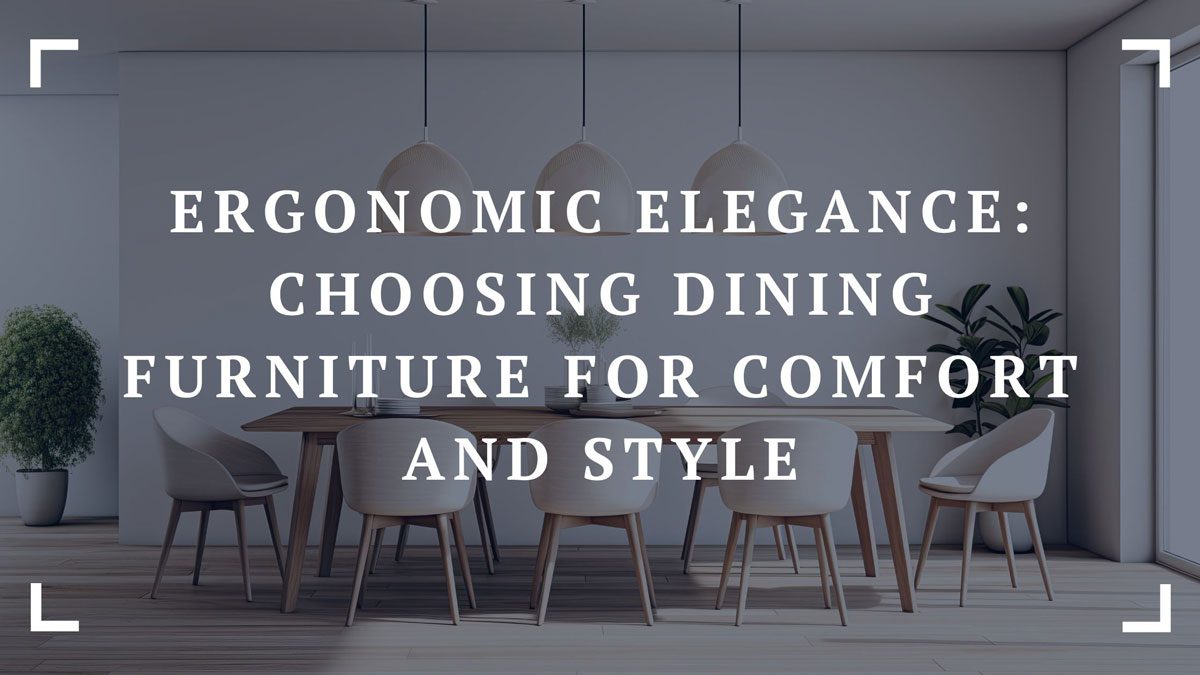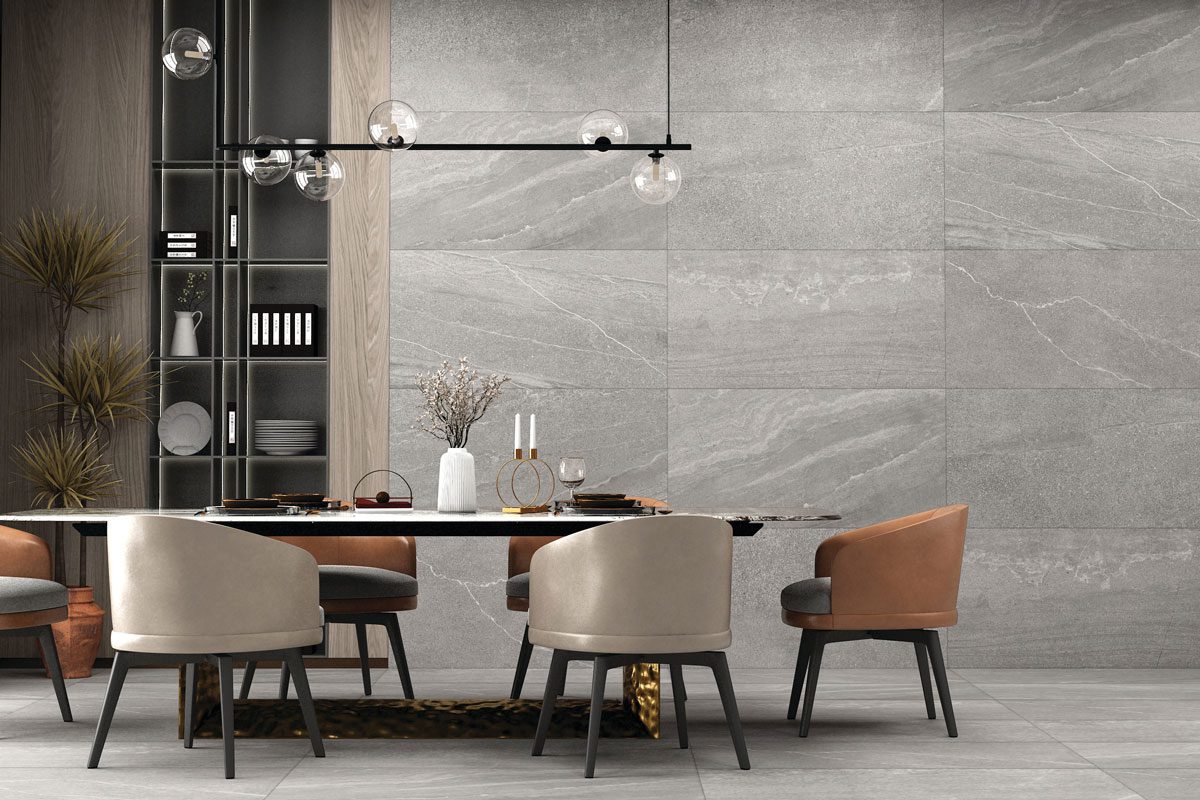In the world of home decor, dining furniture stands out as a centerpiece of both functionality and aesthetic appeal. The convergence of comfort, style, and ergonomics in dining furniture design is a necessity for a wholesome living experience.
This article delves into the art and science of selecting dining furniture that harmonizes ergonomic comfort with stylistic charm. Read on!

Style Meets Comfort
When it comes to furnishing a dining space, the quest for the perfect blend of style and comfort can often feel like a delicate balancing act. This is pivotal in creating an environment where meals turn into memorable experiences and conversations flow effortlessly.
Whether you’re on the hunt for dining furniture Malaysia or anywhere else in the world, here are vital elements to dig into:
1. Material
The material not only influences the style and aesthetic appeal of the furniture but also affects comfort, durability, and maintenance.
Here’s a detailed look at the role of different materials:
Wood
Wood is a classic choice that offers sturdiness and support. Its warmth is inviting, and when shaped properly, it can provide excellent ergonomic support.
Wood can range from traditional oak or cherry to modern bamboo or mango wood, offering a wide variety of finishes and grains to fit any style.
Quality wooden dining furniture is durable and can last for generations. Its comfort level can be enhanced with the addition of cushions or upholstered seats.
Metal
Metal chairs and tables, often made from aluminum, steel, or wrought iron, offer a sleek profile and are usually designed with ergonomics in mind. However, they can be less forgiving than wood in terms of flexibility and warmth to the touch.
Metal furniture fits well in contemporary or industrial-style dining spaces. Its ability to be molded into various shapes allows for creative and stylish designs.
Moreover, metal is extremely durable and easy to maintain. For comfort, pairing metal chairs with cushions is a common practice.
Glass
Glass, typically used for tabletops, creates an illusion of more space and openness. While it doesn’t directly impact seating ergonomics, it can affect the overall dining experience by making spaces feel larger and more inviting.
Glass tabletops can complement various styles, from ultra-modern to traditional, depending on the design of the base and the chairs paired with it.
Glass tables are easy to clean and maintain, although they require careful handling to avoid scratches and breakage.
Upholstery
Upholstered chairs offer enhanced comfort, especially with the right choice of foam and fabric. They provide cushioning and support, essential for prolonged seating.
Upholstery offers endless possibilities in terms of color, texture, and pattern, allowing for personalization and style enhancement.
Furthermore, the comfort level is high with upholstery, but it requires more maintenance, especially in terms of cleaning and ensuring the fabric’s longevity.
Composite Materials
Composite materials, like MDF or engineered woods, and recycled materials, offer a balance between durability and ergonomic design. They’re often used to create more affordable ergonomic designs.
These materials are versatile in terms of finishes and can mimic the look of more expensive materials. Also, while generally durable, they may not have the same longevity as solid wood or metal but are a good choice for eco-conscious consumers.
2. Aesthetic Alignments

It’s important to harmonize the style and visual appeal of dining furniture with the overall decor and ambiance of the space. Below is an exploration of how aesthetic alignments are essential in selecting dining furniture:
Aligning With Interior Themes
The dining furniture should complement the interior design theme of the home. For instance, minimalist designs with clean lines suit modern homes, while ornate and heavy furniture pairs well with traditional decor.
Often, dining furniture serves as the focal point of a dining room. Choosing pieces that stand out in terms of design or color can add a dramatic flair to the space.
Color Coordination
The color of the dining furniture should complement the room’s color palette. This could mean either contrasting boldly or blending seamlessly with the existing colors.
Colors have a profound impact on the mood and ambiance of a room. Lighter colors can create a sense of space and openness, while darker hues offer a feeling of warmth and intimacy.
Texture And Material
The use of different textures in dining furniture (like wood, metal, glass, or upholstery) can add depth and interest to the dining area.
Moreover, consistency or thoughtful contrast in materials can greatly influence the room’s aesthetic. For example, a glass table can complement metal chairs for a modern look, or wood chairs for a more rustic feel.
Scale And Proportion
The size of the furniture should be in proportion to the dining space. Oversized furniture in a small room can feel overwhelming, while too small pieces in a large space might look off. To add, the proportions of the furniture itself, such as the thickness of table legs or the height of the backrest, should be aesthetically pleasing and in balance with each other.
3. Space And Layout Considerations
Properly addressing space and layout considerations ensures that the dining area is comfortable and practical for everyday use. Here are key factors to take into account:
Room Size And Furniture Scale
The size of the dining furniture should be proportional to the room. As mentioned earlier, large, bulky furniture can overwhelm a small space, while too small pieces can seem lost in a large room.
Also, there should be enough room around the dining table for people to move comfortably, ideally allowing 36 to 48 inches between the table and walls or other furniture.
Table Shape And Size
The shape of the table should cater to both the room’s size and the number of diners. Round tables are an awesome fit for smaller spaces; rectangular tables, on the one hand, are ideal for larger rooms and gatherings.
Meanwhile, the table size should accommodate the household’s typical number of diners, with additional space for guests. Standard guidelines suggest about 24 inches of width per person.
Chair Dimensions And Arrangement
Chairs should be sized to fit comfortably under the table, with enough room for diners to sit and stand easily. Their height should align with the table’s height for comfortable seating. Also, adequate spacing between chairs is essential to avoid crowding. Allow for at least six inches between chairs for comfortable seating.
Traffic Flow And Accessibility
The layout should facilitate easy movement around the room, with clear pathways for both servers and diners. Also, consider the needs of all family members, including children and those with mobility issues. Ergonomics isn’t just about comfort but also about accessibility and ease of use.
Lighting And Visual Balance
Adequate lighting is essential for both functionality and ambiance. The dining area should ideally receive natural light, supplemented with artificial lighting for evenings.
In addition, balance the visual weight of the furniture within the room. A heavy, large table might be balanced with lighter chairs, or a bold light fixture can act as a counterpoint to simpler furniture.
Multi-Functional Spaces
In smaller or multi-use spaces, consider adaptable furniture like extendable tables or stackable chairs. In open-plan spaces, on the one hand, use rugs or lighting to define the dining area without obstructing the overall flow of the space.
Practical Tips For Buyers
When shopping for dining furniture that embodies both comfort and style, here are five tips to keep in mind:
- Test For Comfort: Always test the furniture in person if possible. Sit on the chairs for several minutes to get a feel for their comfort level. Pay attention to the back support, seat cushioning, and armrest positioning. Also, ensure the table height is appropriate for the chairs and comfortable for all family members. There should be enough legroom and the table should be at a comfortable height relative to the chairs.
- Measure Your Space: Before purchasing, measure your dining space to ensure the furniture fits comfortably. Remember to account for extra space needed for chairs and walking around the table.
- Consider Your Lifestyle: If the dining area is used daily, prioritize durability and ease of cleaning. For occasional use, you might focus more on style and statement pieces. Consider the needs of all family members, too, including children and the elderly. Look for furniture with rounded edges for safety if you have young children.
- Focus On Quality And Longevity: Look for high-quality materials that promise durability. Solid wood, metal, and tempered glass are typically long-lasting choices. The key here is to view your dining furniture as a long-term investment. It may be worthwhile to spend more upfront for high-quality pieces that will last and remain comfortable for years.
- Check For Customization Options: Look for options to customize furniture according to your specific needs and preferences. Custom pieces can offer a unique style that sets your dining space apart. It also allows for a more personalized ergonomic fit, especially if standard sizes or designs don’t meet your requirements.
- Research and Read Review: Before making a purchase, do thorough online research. Look for reviews and feedback from other customers on comfort, durability, and style. Consider the reputation of the manufacturer or brand. Brands with a good reputation for quality and customer service are generally more reliable. Finally, check the warranty and return policies. Good after-sales service is an indicator of the brand’s confidence in its product quality.
Conclusion
Choosing dining furniture is a delightful blend of art and science. By prioritizing ergonomics without compromising on style, you create a dining space that’s both stunning and comfortable. Remember, the right furniture can transform even the simplest of dinners into memories worth keeping.


